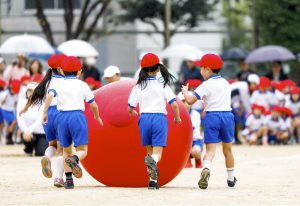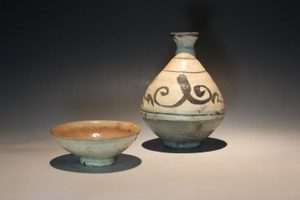Montsuki Hakama
Montsuki (紋付き もんつき)and Hakama (袴 はかま)
A montsuki is garment bearing a family crest or (a kimono with one's family crest on it). Considered formal wear, montsuki were traditionally worn to weddings, official meetings, and other special occasions, though they are rarely seen today. The family crests which appear on these montsuki, however, originated in the Heian period (794-1191) and are still widely used; they vary in design from stylized flowers and plants to animals and everyday objects such as fans, keys, and bells.
Hakama or Haori-Hakama is a long, pleated, culotte-like Japanese traditional garment which worn with montsuki. If Japanese say, “montsuki hakama,” they don’t say it literally sometimes, but meaning a formal attire in a business setting.
Historically in the Edo period (1603-1868), it was used as formal attire in samurai society, but by the middle of the Edo period (1868-1912), it had come to be worn by common men as the most formal attire. In the Meiji period (1868-1912), when the Grand Council of State established formal attire, the black montsuki haori hakama with five crests was adopted, and it became widespread as formal attire since then.
The following are occasions when montsuki hakama are used
- Wedding ceremony
- Wedding - Groom, fathers of both families, guests, etc.
- Funerals - The haori cord is white, as is the case for celebrations, but black or gray is also customary.
- Award ceremonies - Yasunari Kawabata and Tasuku Honjo attend Nobel Prize ceremonies not in tails, but in montsuki haori hakama.
When receiving medals, etc. - According to the rules for wearing medals, etc., this is equivalent to a morning coat. - For formal performances of many modern Japanese music genres, such as koto music, shakuhachi nagauta, etc., and when performing as an accompanist in plays and dances.
- Shogi (Japanese chess) players: Used for title games.
- Sumo wrestlers - This is the formal attire of sumo wrestlers, and is also worn by referees (match judges, or "inspectors" in the old days).
- A rakugo storyteller is allowed to wear it after being promoted to "nitsume."
Examples
彼は"紋付きはかま姿で"現れた. (kareha Montsuki Hakama Sugatade Arawareta.)
He turned up "in montsuki and hakama."
- Categories
- Work in Japan: Japan Biz Cultural Words and 未分類
- Tags
- Montsuki Hakama


